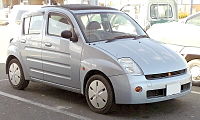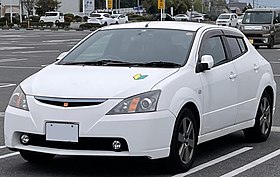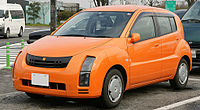
Minivan is a car classification for vehicles designed to transport passengers in the rear seating row(s), with reconfigurable seats in two or three rows. The equivalent classification in Europe is MPV or M-segment.

Nissan Motor Corporation is a Japanese multinational automobile manufacturer headquartered in Yokohama, Kanagawa, Japan. The company sells its vehicles under the Nissan and Infiniti brands, and formerly the Datsun brand, with in-house performance tuning products under the Nismo and Autech brands. The company traces back to the beginnings of the 20th century, with the Nissan zaibatsu, now called Nissan Group.

The Renault Mégane, also spelled without the acute accent as Megane, especially in languages other than French, and also known as the Renault Megavan for an LCV in Ireland, as the Renault Scala in Iran and as the Renault Mégane Grandcoupé for the saloon in Israel, Palestinian Authority and Serbia for certain generations, is a small family car produced by the French car manufacturer Renault for the 1996 model year, and was the successor to the Renault 19. The Mégane has been offered in three- and five-door hatchback, saloon, coupé, convertible and estate bodystyles at various points in its lifetime, and having been through four generations is now in its fifth incarnation.

The Renault Scénic, also spelled without the acute accent as Scenic, especially in languages other than French, is a car which was produced by French car manufacturer Renault, the first to be labelled as a small multi-purpose vehicle (MPV) in Europe. The first generation was based on the chassis of the Mégane, a small family car. It became the 1997 European Car of the Year on its launch in November 1996. In May 2022 Renault announced it was discontinuing the standard Scénic with the Grand Scénic following shortly after. It will be relaunched in 2024 as a fully electric vehicle called the Renault Scénic E-Tech which will be the production version of the Renault Scénic Vision concept unveiled in 2022, with the production version to be unveiled at the 2023 Munich Motor Show on September 4.

The Scion xB is a compact car made by Scion, a now-defunct fully owned division of Toyota, for the United States market. It is a box-shaped, 5-door hatchback.
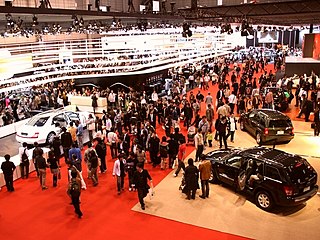
The Japan Mobility Show (ジャパンモビリティショー) (TMS) is a biennial auto show held in October–November at the Tokyo Big Sight, Tokyo, Japan for cars, motorcycles and commercial vehicles. Hosted by the Japan Automobile Manufacturers Association (JAMA), it is a recognized international show by the Organisation Internationale des Constructeurs d'Automobiles, and normally sees more concept cars than actual production car introductions which is the reason why the auto press see the show as one of the motorshow's big five.

The Toyota Ist is a subcompact car manufactured by the Japanese automaker Toyota. It is exported to the United States as the Scion xA and Scion xD, the Middle East as the Toyota xA and to Europe and Latin America as the Toyota Urban Cruiser for the second generation.
Motorcars first arrived in Mexico City in 1903. Since then, several vehicle brands have been especially successful. A number of manufacturers make vehicles in Mexico, and many brands have been and continue to be available.

The Renault Mégane Renault Sport is a series of high-performance hatchback models based on the Renault Mégane, produced since 2004 by the high-performance subsidiary company Renault Sport for its parent company Alpine, a subsidiary of Renault. The Mégane RS won awards such as "Best hot hatch" from What car? (2010–2014), "Highest placed non-supercar" in Evo's annual Car of the Year test 2011 and "Best hot hatch" from Top Gear.

The Toyota Auris is a compact car derived from the Corolla, manufactured and sold by Toyota. Introduced in 2006, the first generation three/five-door hatchback shared the platform with the E150 series Corolla, while the second generation five-door hatchback and station wagon called "Touring Sports" uses the E180 platform. The "Auris" name is based on the Latin word for "gold", "aurum".

The Toyota Sprinter Marino is a four-door B-pillar hardtop sedan version of the Toyota Sprinter sedan produced between 1992 and 1998 for sale in Japan. The Toyota Corolla Ceres is a slightly restyled version of the Sprinter Marino, as was common practice by Japanese automakers in the 1980s and 1990s.

Sociedad de Fabricación de Automotores (SOFASA) is a Colombian company that assembles imported Renault and, in the past, Toyota and Daihatsu Delta vehicles. It was the first company to produce the Renault Logan in the Americas. In addition to Logan also manufactured Renault Clio, Renault Symbol, Renault Megane and Renault Twingo. It also manufactured trucks like Toyota Prado, Toyota Land Cruiser, Toyota Hilux and Daihatsu Delta. The company exports to the Andean Community of Nations (CAN) and supplies the national market of automobiles in Colombia. Currently, Renault is the sole shareholder of the company. As of 2019 the capacity of the company reached 70 000 cars per year making it the biggest car exporter in the region.
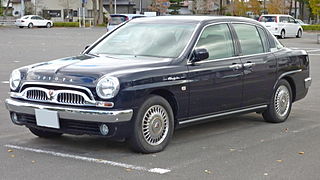
The Toyota Origin is a limited edition mid-size car made by Toyota and sold in Japan between 2000 and 2001, having been launched in November 2000. It was planned that only 1,000 models would be built, but, in fact, 1,073 were produced. In Japan, it was sold at Toyota Store, Toyopet Store and Corolla Store Japanese dealerships.
The Toyota NBC platform is an automobile platform for subcompact cars from Toyota. "NBC" stands for "New Basic Car" or "New Basic Compact". The NBC platform made its debut in January 1999 with the first generation Vitz; as such, it is also called the "Vitz platform". It is replaced by the newer B platform.

The Tokyo Auto Salon is an annual auto show held in January at the Makuhari Messe, Chiba City, Japan for Performance and custom aftermarket parts and technology displays. Hosted by the Nippon Auto Parts Aftermarket Committee (NAPAC), the Tokyo Auto Salon is one of the top motor shows globally for modified and tuned cars. The 2019 Tokyo Auto Salon featured 906 vehicles, 426 exhibitors, and 4,175 booths that offered aftermarket accessories for purchase. There are also after-market parts manufacturers, custom shops, care manufacturers, automotive businesses, and automotive vocational schools. There are not only custom cars and after-market manufacturers, there is also live entertainment. Top musicians from around the world and talk shows hosting famous drivers and celebrities can be seen at the Tokyo Auto Salon.
Central Motor Co., Ltd. was a Japanese manufacturer of cars within the Toyota Group. It was founded on 4 September 1950 by Ryuichi Tomiya. The company operated five plants, all located in Japan. It was one of the biggest export vehicle manufacturers of the concern. In July 2012 it was merged with two other Toyota subsidiaries operating in Tohoku to form Toyota Motor East Japan.
France was a pioneer in the automotive industry and is the 11th-largest automobile manufacturer in the world by 2015 unit production and the third-largest in Europe. It had consistently been the 4th-largest from the end of World War II up to 2000. It is 16% of sales of French manufactured products.
A retro-style automobile is a vehicle that is styled to appear like cars from previous decades. Often these cars use modern technology and production techniques. This design trend developed in the early 1990s and led to almost all automobile brands introducing models that referenced previous cars of the 1950s and 1960s.

The Toyota 86 and the Subaru BRZ are 2+2 sports cars jointly developed by Toyota and Subaru, manufactured at Subaru's Gunma assembly plant.
The Common Module Family (CMF) is a modular architecture concept jointly developed by car manufacturers Nissan and Renault through their Renault–Nissan–Mitsubishi Alliance partnership. The concept covers a wide range of vehicle platforms.



